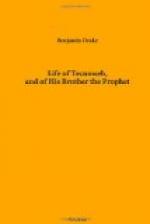On the 15th of August, the garrison of Chicago, situated in the south-western bend of lake Michigan,—consisting of about seventy men, with some women and children,—were attacked by a large body of Indians, who had been lying around the fort for some time, professing neutrality. The whole were either murdered or taken prisoners. The garrison, under the direction of captains Heald and Wells, having destroyed the fort and distributed the public stores among the Indians, was about to retreat towards fort Wayne. As the Indians around Chicago had not yet taken sides in the war, the garrison would probably have escaped, had not Tecumseh, immediately after the attack upon major Vanhorn, at Brownstown, sent a runner to these Indians, claiming the victory over that officer; and conveying to them information that general Hull had returned to Detroit; and that there was every prospect of success over him. This intelligence reached the Indians the night previous the evacuation of Chicago, and led them at once, as Tecumseh had anticipated, to become the allies of the British army.
At the period of colonel Campbell’s expedition against the Mississinaway towns, in the month of December, Tecumseh was in that neighborhood, with about six hundred Indians, whose services he had engaged as allies of Great Britian. He was not in the battle of the river Raisin on the 22d of January. Had he been present on that occasion, the known magnanimity of his character, justifies the belief that the horrible massacre of prisoners, which followed that action, would not have taken place. Not only the savages, but their savage leaders, Proctor and Elliott, would have been held in check, by a chief who, however daring and dreadful in the hour of battle, was never known to ill-treat or murder a prisoner.
CHAPTER XII.
Siege of fort Meigs—Tecumseh commands the Indians—acts with intrepidity—rescues the American prisoners from the tomahawk and scalping knife, after Dudley’s defeat—reported agreement between Proctor and Tecumseh, that general Harrison, if taken prisoner, should be delivered to the latter to be burned.
Fort Meigs, situated on the south-east side of the Miami of the lakes, and at the foot of the rapids of that stream, was an octagonal enclosure, with eight block houses, picketed with timber, and surrounded by ditches. It was two thousand five hundred yards in circumference, and required, to garrison it with efficiency, about two thousand men. It was constructed under the immediate superintendence of colonel E. D. Wood, of the corps of engineers, one of the most scientific and gallant officers of the late war. This post, which was established in the spring of 1813, was important not only for the protection of the frontiers, but as the depot for the artillery, military stores and provisions, necessary for the prosecution of the ensuing campaign. These circumstances could not fail to attract the attention of the enemy; and the commander of the American army was not disappointed in supposing that fort Meigs would be the first point of attack, upon the opening of the spring, by the combined forces of Proctor and Tecumseh.




